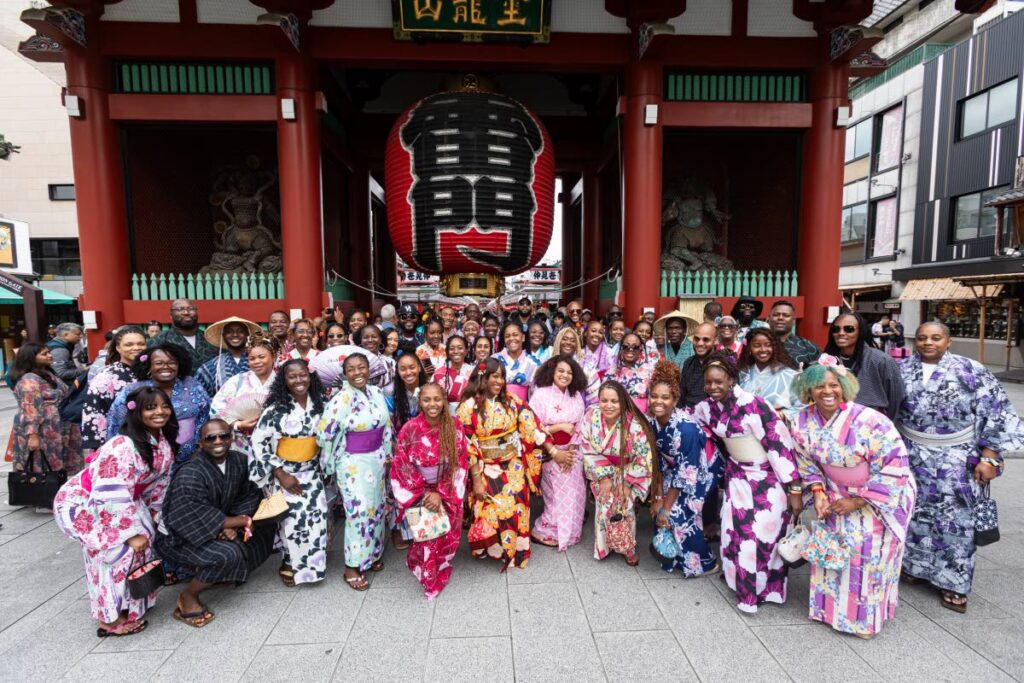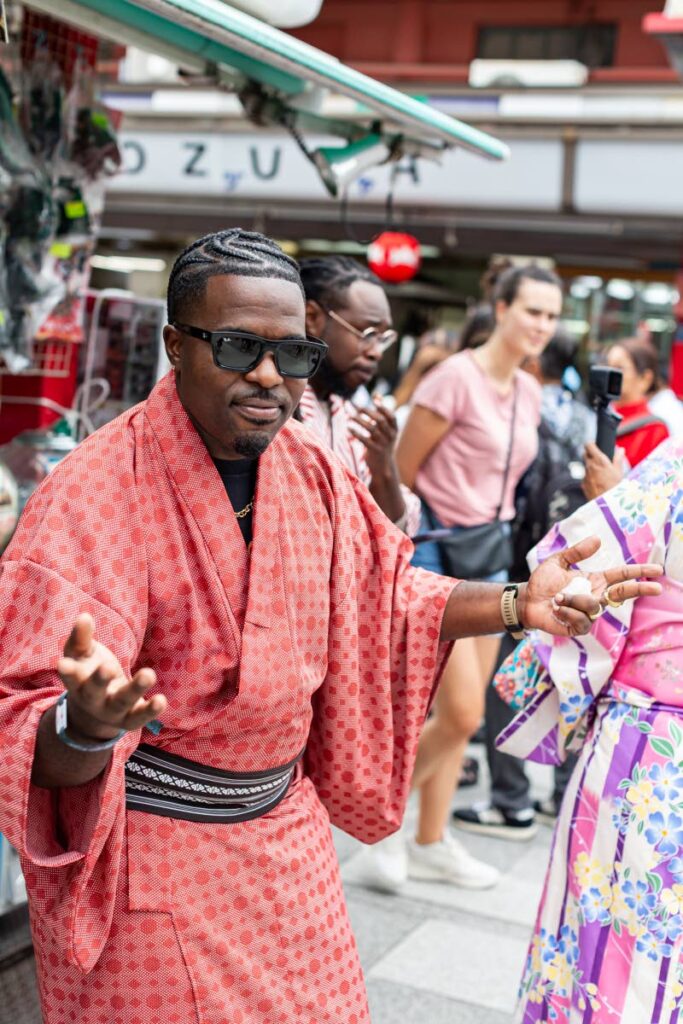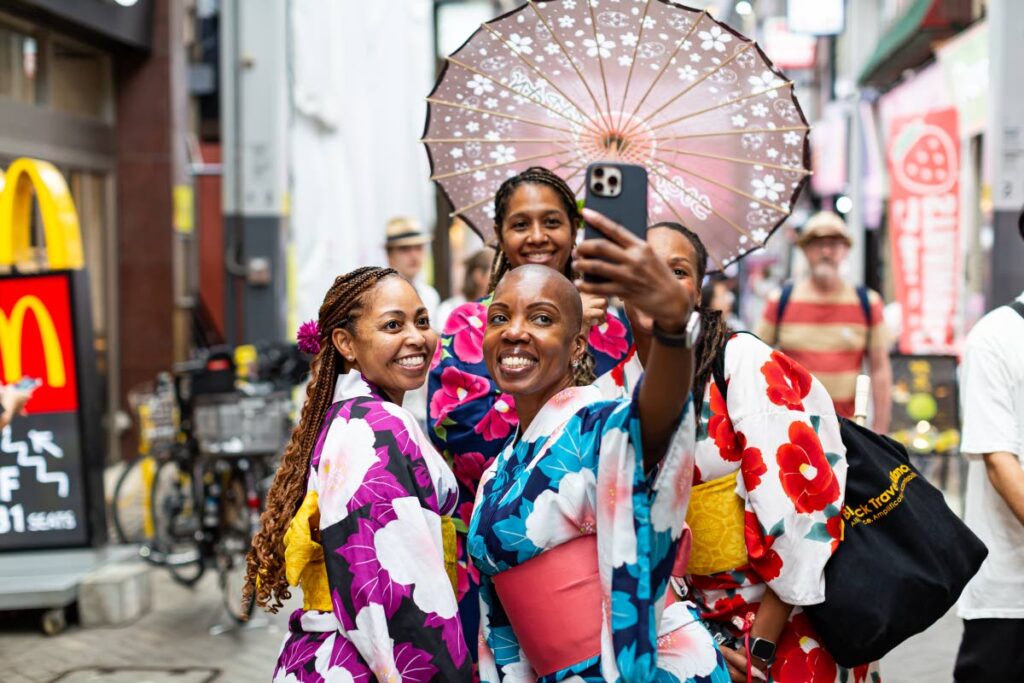Features
Rhianna Mc Kenzie
2 Hrs Ago
 Group photo of Soca in Japan participants at Asakusa Senso-ji Buddhist Temple in Tokyo Prefecture, Japan during the annual Soca In Japan festivities in September. – RealShot MASATO
Group photo of Soca in Japan participants at Asakusa Senso-ji Buddhist Temple in Tokyo Prefecture, Japan during the annual Soca In Japan festivities in September. – RealShot MASATO
Rhianna Mc Kenzie
THE streets of Tokyo, Japan were, once again, trekked by hordes of West Indians visiting for the annual lineup of Soca In Japan (SIJ) festivities from September 19-23. Some newcomers and a few faithful returnees were all eager to immerse themselves in Eastern culture, which included tours of historic sites such as Asakusa Senso-ji Buddhist Temple and cultural events like Sumo wrestling, the national sport of Japan. All of this, while still managing to get their annual carnival fix through fetes, boat rides and anime-themed soca events in and around the capital, culminating in the third annual Japan Caribbean Carnival (JCC) – an authentic, Caribbean-styled street parade – in Saitama Prefecture, all part of the Japan Soca Weekend (JSW) concierge experience.
This year, SIJ returnees included two-time guest artistes, TT producer and musician Keshav Chandradath Singh, TT-born, New York-based Jelani “DJ Jel” Roberts and three-time returnee Boris “DJ Mad Russian” Shapiro. Newcomers, soca artistes Akeem “Preedy” Chance and Andre “Viking Ding Dong” Houlder, were this year’s talent, following the likes of Nailah Blackman and Mical Teja in 2023 and Vincentian soca star Johnny “Problem Child” Fontainne in 2024.
The JCC parade, held at a secluded race track in the Saitama countryside, attracted quite a few local spectators, who watched in awe, some with children in tow, as masqueraders danced behind the music truck, making laps around the track. Spectators were particularly impressed by both the traditional Japanese and Trinidadian rhythm sections that performed on the sidelines, with the Japanese drummers eventually making their way to the track to add to the already lively parade. Another show stopping performance, by Japanese steel band Panorise, effortlessly serenaded the joyful crowd with soca classics like Bunji Garlin and Machel Montano’s Famalay.
Surreal experience for newcomers
Self-proclaimed cultural ambassador Preedy described his first trip to Japan as nothing short of amazing. Speaking to Newsday at JCC on Sept 23, Chance said, “The experience has been surreal. Every morning I wake up and I am so happy to know that the class clown, the guy that they were not expecting to become anything, is here in Japan representing the red, white and black and being paid for a talent that was once deemed a nuisance.”
He said he had been contacted some years ago about participating in SIJ, but had turned it down. “I think I was just young and didn’t really understand what was happening here, so when they called me again, I dived at it. To be able to get on a plane to do what you love to do, especially in remote regions, is amazing.”
Chance said he wasted no time in getting to know more about the place he was visiting, joking that he learned a phrase or two to get him through the trip. “ I can say, ‘Konnichiwa’ (Hello) and, ‘O genki dese ka?’ (Are you OK?),” he joked, adding, the culinary experience was also unique.
“The food is very clean,” he said. “They love to taste the freshness of the meat. It was a bit much to get accustomed to. I found a TGIF restaurant today, so I was happy,” he said with a laugh.
Throughout his trip, Chance had been posting on his social media about his experience, asking his fans to offer suggestions about what foods to try and posting videos of him taking their suggestions. Through his social media, he tried culinary classics like sushi, ramen and tonkatsu (deep-fried, breaded pork cutlets). “I wish I was staying a bit longer to explore some more.”
As for the SIJ experience, Chance said he was in awe of the work being done to promote Caribbean culture and soca music in this part of the world. “I can see (the Japanese people) genuinely want to show the culture respect. We need to take more pride in our culture that we throw to the side and only do once a year. We do not see our culture for the goldmine that it is.
“It is very heart warming to see how much love the culture is getting here. I performed music that I don’t even perform in TT and they were singing to the top of their lungs bouncing their little tiny Japanese bam bam up and down,” Chance said with a laugh.
 Soca artiste Akeem “Preedy” Chance at Asakusa Senso-ji Buddhist Temple in Tokyo Prefecture, Japan during the annual Soca In Japan festivities in September. – RealShot MASATO
Soca artiste Akeem “Preedy” Chance at Asakusa Senso-ji Buddhist Temple in Tokyo Prefecture, Japan during the annual Soca In Japan festivities in September. – RealShot MASATO
Chance emphasised the need for local governments, particularly in TT, to invest more into the export and tourism capabilities of soca music and Carnival. “I would love to see the tourism ministry take example from cultural ambassadors such as myself who don’t get paid to be cultural ambassadors. Use us to market the culture because we are already doing it…I fly the (TT) flag with pride and this gives the younger ones the encouragement to (travel) and see the world.” He also highlighted the need to export other aspects of the culture, and not just the parts that are appealing to foreign audiences. “Because there is no regulation on the export of carnival, most of the time it is the surface level part of it (that gets attention). The costumes, the music, but not all the music. Calypso is not exported as much. The traditional characters, as well. I was privileged to play in a Japanese rhythm section. That was extremely fun.”
He said, even though Japanese culture is reserved, some of TTs risque costumes may not resonate with the people, but other things can. “I’m sure the sound of a steelpan, the sight of a moko jumbie, or the king and queen of Dimanche Gras will surely entice them.” He also encouraged TT’s leaders to bring more cultural elements back to the schools to encourage up-and-coming talent that TT culture is a worthy investment of their time. “You see a young man such as myself, this pays my bills. I does pay my taxes,” he said loudly, laughing. “The government needs to invest more to exposing the world into how amazing Trinidad is.”
Ding Dong also had kind words for the people of Japan. “This was my first time (here) and, I must say, it was an extraordinary experience. The sites, the views, the food, it was all something out of this world.” He highlighted his visit to Asakusa Temple and the Samurai Ninja Museum, where he was able to learn more about the history and culture of the country. He said the teamLab: Borderless attraction, an immersive digital art museum, was also a memorable experience as it highlighted the wonder of the country’s signature technological advancements.
 Patrons, dressed in kimonos, take a selfie at Asakusa Senso-ji Buddhist Temple in Tokyo Prefecture, Japan, during the annual Soca In Japan festivities in September. – Photos courtesy RealShot MASATO
Patrons, dressed in kimonos, take a selfie at Asakusa Senso-ji Buddhist Temple in Tokyo Prefecture, Japan, during the annual Soca In Japan festivities in September. – Photos courtesy RealShot MASATO
Houlder described his SIJ experience as a good representation of Caribbean culture. “Caribbean people love congregating in the name of fun, love and revelry. I observed this during my experience here and believe it will continue to grow as others see the welcoming spirit of Japan.” He urged the TT government and other Caribbean leaders to exercise a more intentional use of available technology as a tool to achieve the continued efforts to export Caribbean culture in non-Caribbean spaces. “Use modern day resources, inclusive of social media, to highlight and generate awareness of cultural events and align those efforts with festivals like this.”
Houlder said, carnival as a travel destination experience is a worthy investment for patrons. “There is nothing like it! So much to see, do, taste, touch and experience. Not only speaking from a cultural point of view, but it is also a great opportunity for networking or simply meeting new people from all over the world in one happy place.
“My hope is that the good music and good vibes emanating out of the Caribbean continues to touch the hearts of many worldwide. I also want our younger generation to preserve and cherish our rich and vibrant culture for many years to come, something I see Japan holds true with their own.”
SIJ seeing “tremendous” growth
“Have you ever watched something get better and better and grow?” DJ Mad Russian asked. “That’s exactly what it is. The first year was good, the second year was better and this is the best so far.” He praised the team for doing a great job in promoting the event, citing many of the kinks from the previous two installments had been worked out.
He said the event’s major setback is the cost to get to the country. “Flights are very expensive. I know there are some people here in Europe. It might be cheaper for them. For the rest of us living in North America, South America, it’s expensive. Flights can be about 1500-2000 just to get here. It’s excessive.”
Shapiro joked that there really isn’t much that you can say to convince anyone to dish out that kind of money for a trip. “You just have to want to come out here and see what’s happening for themselves.”
He described the weekend as a beautiful blend of the imported Caribbean culture and the local Japanese culture which is what makes the experience so unique and worthwhile. “Those that are interested will come. Those that don’t know about it will find out about it and they’ll come. Those that can’t, will miss out. Who vex, loss.”
Shapiro dazzled the crowd with his 2025 Vincy Mas release, Horn is Horn.
He said the song did well at Vincy Mas earlier this year and is excited to see what next year will bring.
Keshav Singh, said he was also impressed by how much the festival has grown since his visit in 2024. “It has grown exponentially. I was looking at the tour buses. It was like three last year and eight this year. All of the events were (sold out). I am very proud of that. I have been working in this territory for four years now and we’ve been slowly but surely installing soca into the consciousness of Japan and SIJ helps with that.” Trini SIJ costume designer Apphia Pereira told Newsday that the only setback to promoting the event further is visibility. She said, in comparison to cultures as ancient as Japan, Trinidad is still a new country. “We have a strong, rich culture. I am not denying that, but Japan is so old and there is so much to see and do.” She said so many people back home have a vested interest in Japanese culture, but other than English teaching programmes, there aren’t many other avenues to come to the country. “We need to create more opportunities for our people to come and experience the culture and mix into the culture.”
Pereira’s design, Rinka Foxfire, stayed true to this year’s theme, Spirit of Kitsune, by focusing on the orbs of light that traditionally surround the mythical fox which reflects the power it gets from the moon. Pereira incorporated elements of bioluminescent fungi present in decaying wood on the forest floors of Japan where the myth is said to have originated. Kitsune is better known as the nine-tailed fox in Japanese folklore.
Event organiser Kegon Toussaint, in an interview with Newsday a few days after the event, wanting to ensure patrons had returned home safely, said while he could not disclose the exact number of clients they hosted this year, he was able to confirm tremendous growth across all events. “In some cases, events doubled and even tripled in size compared to last year. It’s really a testament to our mission of continuing to expand.”
Toussaint, who started the company in 2017, had said in a 2022 interview with Newsday that he saw the potential for soca tourism in Japan, not only among the Caribbean expat community, but also among Japanese residents who had travelled to the Caribbean and were familiar with the culture. Despite seeing a higher traffic of patrons this year, getting the event off the ground was not without its challenges. “Soca culture isn’t the culture of Japan, and for many people, it’s their first time traveling here. That means not everyone is comfortable navigating on their own. We had to figure out how to move and process very large groups – something that’s unusual since most tours in Japan are kept small.


AloJapan.com